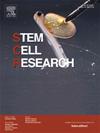2例BAG3 P209L肌原纤维性肌病患者诱导多能干细胞(iPSC)系的生成
IF 0.7
4区 医学
Q4 BIOTECHNOLOGY & APPLIED MICROBIOLOGY
引用次数: 0
摘要
作为伴侣辅助选择性自噬(CASA)复合体的成员,BAG3对肌肉蛋白的周转很重要。BAG3基因626位点突变(p.P209L, c.p 626c>;T, chrr .10q26)的患者患有多发性神经病变和严重肌原纤维性肌病-6 (MFM6)。后者表现为骨骼肌营养不良和限制性心肌病。为了建立MFM6模型,我们从患有这种变异的患者身上获得了两个非等基因的人类诱导多能干细胞(iPSC)系。多能性分析和胚层分化检验iPSC质量。这些hipsc能够表征MFM6的病理生理学和测试新的实验治疗方法。本文章由计算机程序翻译,如有差异,请以英文原文为准。
Generation of human induced pluripotent stem cell (iPSC) lines from two patients with BAG3 P209L myofibrillar myopathy-6
As member of the chaperone-assisted selective autophagy (CASA) complex, BAG3 is important for the turnover of muscle proteins. Patients with a point mutation at position 626 in the BAG3 gene (p.P209L, c.626C>T, Chr.10q26) suffer from polyneuropathy and severe myofibrillar myopathy-6 (MFM6). The latter manifests as skeletal muscle dystrophy and restrictive cardiomyopathy. To model MFM6, we generated two non-isogenic human induced pluripotent stem cell (iPSC) lines from patients with this variant. Pluripotency analyses and germ layer differentiations were performed to check the iPSC quality. These hiPSCs enable the characterization of the pathophysiology of MFM6 and testing of new experimental therapeutic approaches.
求助全文
通过发布文献求助,成功后即可免费获取论文全文。
去求助
来源期刊

Stem cell research
生物-生物工程与应用微生物
CiteScore
2.20
自引率
8.30%
发文量
338
审稿时长
55 days
期刊介绍:
Stem Cell Research is dedicated to publishing high-quality manuscripts focusing on the biology and applications of stem cell research. Submissions to Stem Cell Research, may cover all aspects of stem cells, including embryonic stem cells, tissue-specific stem cells, cancer stem cells, developmental studies, stem cell genomes, and translational research. Stem Cell Research publishes 6 issues a year.
 求助内容:
求助内容: 应助结果提醒方式:
应助结果提醒方式:


